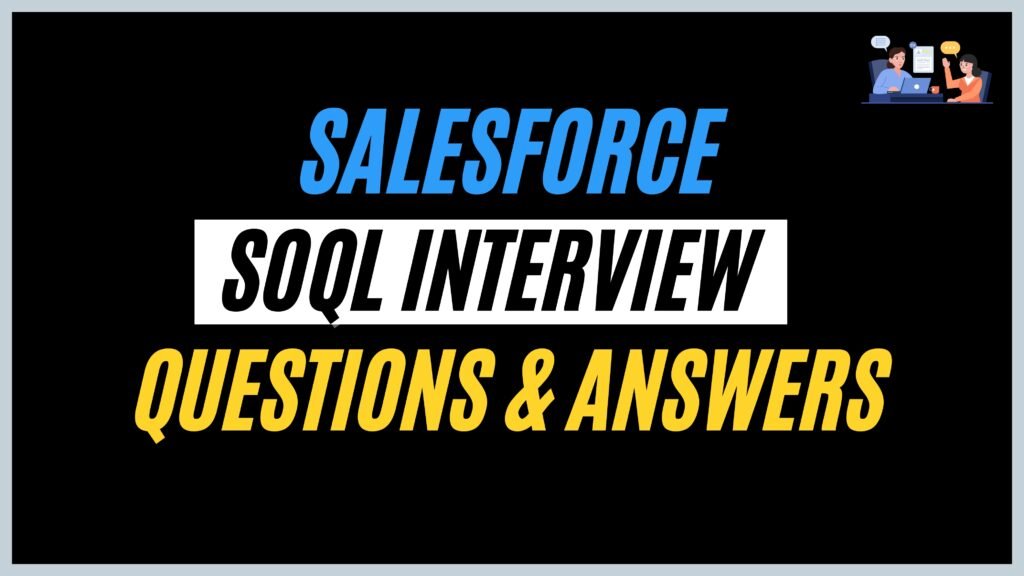SOQL Scenario-Based Interview Questions and Answers

Salesforce Object Query Language is how you fetch data stored in Salesforce. It works like SQL but is designed for Salesforce objects and records. You can use SOQL to query both standard objects like Account or Contact and custom objects such as Invoice__c.
SOQL lets you filter, sort, and access related records using relationship queries. It’s an essential skill for developers and admins who want to retrieve or analyze data efficiently.
In this blog, we’ll focus on scenario-based interview questions to help you understand how SOQL works in real-world Salesforce projects and how to write optimized, effective queries.
Let’s move forward with SOQL Scenario-Based Interview Questions and Answers
Question 1. What is SOQL?
Like SQL, but particularly for Salesforce, SOQL (Salesforce Object Query Language) is used to export data from Salesforce.
Question 2. Can we use SOQL in a trigger?
SOQL is commonly used inside Apex triggers to fetch related records, But It must be optimized to avoid hitting governor limits (like the 100-query limit).
Question 3. How many records does a single SOQL query return?
Governor limits will allow us to query Apex using SOQL up to 50,000 records.
Question 4. How do SOSL and SOQL differ?
SOQL queries data from one object or a group of related objects. SOSL, on the other hand, searches across many objects at once.
Question 5. What are relationship queries in SOQL?
Relationship queries allow access to parent or child records using dot notation, for example:
Question 6. What is a subquery in SOQL?
Subqueries fetch child records using relationship names, for example:
Question 7. Is it possible to use aggregate functions in SOQL? If yes, can you give an example?
We can use these SOQL functions: COUNT(), SUM(), AVG(), MIN() and MAX(). For example:
Question 8. How will the WHERE keyword be used in SOQL?
WHERE Keyword is used with filtering conditions, like
Question 9. What is the purpose of LIMIT in SOQL?
The LIMIT Clause is used to restrict the number of records returned by the query. For example:
Question 10. How do we sort SOQL results?
SOQL results can be sorted using the ORDER BY clause, either in ascending or descending order. You can also control the placement of null values using NULLS FIRST or NULLS LAST. For example:
Question 11. How to avoid null parent reference errors in relationship queries?
To avoid null parent reference errors in relationship queries, make sure you always check whether the parent record actually exists before accessing its fields.
Question 12. How can we query for records created today?
Question 13. What is the use of the “IN” operator in SOQL?
The IN operator in SOQL is used to filter records where a field’s value matches any value in a given list or subquery. It’s similar to using multiple OR conditions but is more efficient and cleaner.
Question 14. How can we perform semi-join queries in SOQL?
SOQL doesn’t use traditional SQL joins, but it does support relationship queries.
Question 15. What is the maximum number of records a SOQL query can return per request?
In API version 28.0 and later, a SOQL query can return up to 2,000 records per request, including child records, unless you use a custom LIMIT. Earlier API versions return only 200 records. When the query runs inside Apex, additional governor limits also apply.
Question 16. How can we query for records owned by the running user?
Question 17. How can we query data from a custom object?
Use the API name ending with __c. For example
Question 18. Can we use GROUP BY in SOQL?
Yes, we can use GROUP BY in SOQL. It helps you group records based on a field.
Question 19. Difference between COUNT() and COUNT(Id) in SOQL?
COUNT() returns the number of records, including rows where the ID might be missing, whereas COUNT(Id) returns the number of records only where the ID is not null.
Question 20. Can SOQL queries be dynamic?
In Apex, you can build SOQL statements at runtime by constructing the query as a string and passing it to Database.query().
Question 21. What are polymorphic relationships in SOQL?
A polymorphic relationship happens when one lookup field can point to different types of objects. Salesforce fields like WhoId and WhatId work this way. SOQL also gives special options to query these types of fields.
Question 22. How do we handle governor limits when querying large data?
We can handle governor limits for large data by using techniques like selective filters, using LIMIT and OFFSET wisely, and querying only the fields we need. For very large datasets, we should use Batch Apex, QueryLocator, or asynchronous processing so Salesforce can handle the data in smaller chunks without hitting limits.
Question 23. Can we use WHERE with aggregate queries?
We can use WHERE to filter records before aggregation, and HAVING to filter the grouped results after using GROUP BY.
Question 24. Can SOQL return records from several unrelated objects?
SOQL only works when objects are related through parent-child or child-parent relationships. If objects have no relationship, we must run separate queries or use Apex to combine the results.
Question 25. What is the maximum OFFSET value allowed in SOQL, and what error do you get if you exceed it?
You can only use OFFSET up to 2,000 rows in SOQL. If you try to go past 2,000, Salesforce will return a NUMBER_OUTSIDE_VALID_RANGE error.
Question 26. What are the best practices for writing SOQL in Apex?
- Avoid using SOQL inside loops
- Query only required fields
- Filter on indexed fields whenever possible to improve performance
- Query parent or child records in a single SOQL when appropriate
- Use Batch Apex, QueryLocator, or asynchronous methods for big datasets
Question 27. In SOQL, is there a limit to how many child-to-parent relationships you can reference in a single query?
Yes, there is a limit. In SOQL, you can reference up to 55 child-to-parent relationships in a single query. Out of this, a custom object supports up to 40 such relationships.
Question 28. How to fetch deleted records in SOQL?
Question 29. Can we query records from the Recycle Bin?
SOQL can fetch Recycle Bin records when using ALL ROWS. This returns both active and deleted records.
Deleted records will have ‘IsDeleted = true’
Question 30. How can you write a SOQL query to fetch all Contacts whose parent Account belongs to a specific Industry, such as ‘Technology’?
Question 31. How do you write a SOQL query to find all Accounts that don’t have any related Contacts?
Question 32. How would you write a SOQL query to fetch the top 5 Opportunities by Amount for a given Account?
Question 33. How would you write a SOQL query to find all active users who own more than 10 Accounts?
Question 34. How would you write a SOQL query to fetch all Accounts that were modified in the last seven days?
Question 35. How would you query all Contacts whose parent Account has a Rating of ‘Hot’?
Question 36. How would you write a SOQL query to calculate the total Opportunity Amount grouped by Stage?
Question 37. How would you write a SOQL query to find all Accounts that have at least one Opportunity closed this month?
Question 38. How would you write a SOQL query with nested subqueries to export Accounts along with their related Contacts and Cases?
Question 39. How would you write a SOQL query to find all Accounts that have more than three Contacts?
Question 40. How would you write a SOQL query to fetch the latest Opportunity for each Account?
Question 41. How would you write a SOQL query to find Accounts that haven’t been updated in the last 90 days?
Question 42. How would you write a SOQL query to get the total number of Contacts grouped by their Account Owner?
Question 43. How would you write a SOQL query to fetch Opportunities where the custom Discount field is greater than 10%?
Question 44. How would you write a SOQL query to find all Accounts whose related Contacts use Gmail addresses?
Question 45. How would you write a SOQL query to retrieve all Task IDs related to the ‘Edge Communications’ Opportunity, along with the Opportunity Name?
Question 46. In Salesforce, how can you check what level of access a specific user has to a particular record using SOQL?
Looking to learn Salesforce Flow? Check out the complete Salesforce Flow Mastery Course here
Conclusion
These 45+ SOQL interview questions cover every level, from the basics like filtering and relationship queries to advanced real-time and scenario-based use cases. The focus in today’s Salesforce interviews is not just knowing SOQL syntax but how efficiently it’s used within Apex and large data environments. Understanding governor limits, selective filters, and indexed fields can make a huge difference between a good and great developer.

